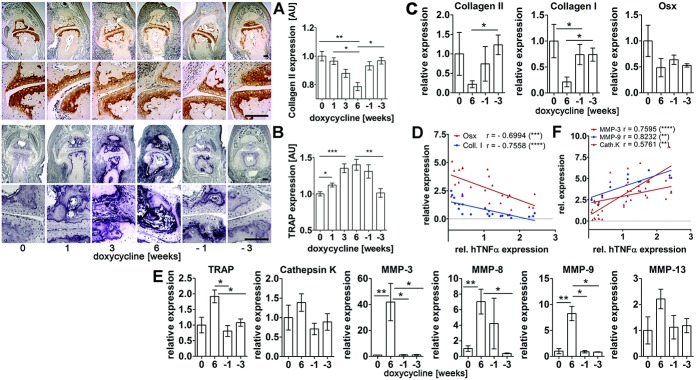Figure 1.

Expression of human tumor necrosis factor α (hTNFα) in doxycycline (Dox)–inducible human TNFα–transgenic mice after doxycycline administration. A and B, Systemic doxycycline-induced human TNFα (n = 8, 4, 9, and 6 mice for increasing concentrations shown) (A) and S100A8/A9 proteins (n = 6, 4, 5, and 6 mice for increasing concentrations shown) (B) in mouse serum, as determined by enzyme-linked immunosorbent assay. C, Transcriptional expression of human TNFα in tissues of untreated control mice and mice treated with doxycycline (0.5 mg/ml for 6 weeks), as analyzed by TaqMan quantitative reverse transcription–polymerase chain reaction. The amount of mRNA in fore paws of control mice was assigned a value of 1. Numbers of animals analyzed are shown above columns. D and E, Changes in body weight (D) and swelling of fore paws (E) during stimulation with various concentrations of doxycycline (n = 4 mice per time point for each group of mice). Values in A–E are the mean ± SEM. ∗∗ = P < 0.01; ∗∗∗ = P < 0.001 for doxycycline-treated mice versus untreated mice. F, Magnetic resonance imaging of fore paws before and after injection of contrast agent (CA; 0.5 mmoles/kg) (n = 5 mice per group). Arrowhead indicates prominent swelling of digits after doxycycline treatment. Bar = 1 mm. G, 18F-fluorodeoxyglucose (18F-FDG) positron emission tomography imaging showing locally increased 18F-FDG uptake as a surrogate marker for inflammatory activity in distal interphalangeal joints of doxycycline-treated (arrowheads) (n = 5 mice per experiment) but not untreated (control; n = 3 mice per experiment) doxycycline-inducible human TNFα–transgenic mice. In addition, a typical high uptake of the tracer by the heart and its excretion-based accumulation in the urinary bladder was always observed in both control and doxycycline-treated mice. Color figure can be viewed in the online issue, which is available at http://onlinelibrary.wiley.com/doi/10.1002/art.38026/abstract.
